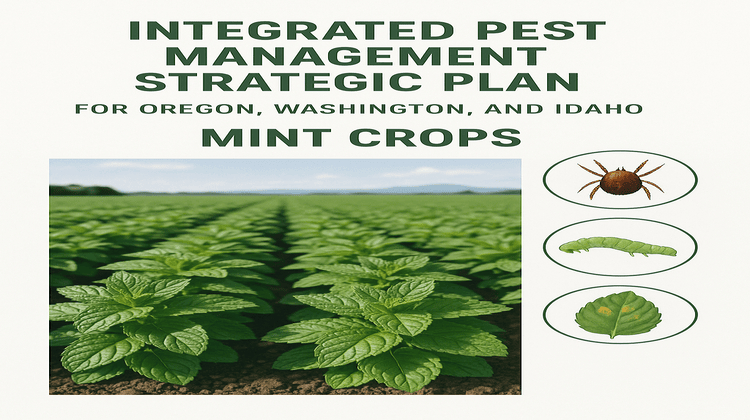Integrated pest management strategic plan for Oregon, Washington and Idaho mint crops
Discover sustainable Integrated Pest Management strategies for mint crops in Oregon, Washington, and Idaho to boost yields and reduce pest impact.

Integrated Pest Management (IPM) is a comprehensive approach to managing pests that emphasizes sustainable, environmentally compatible, and economically viable practices. Having a good Integrated Pest Management (IPM) plan is critical for Oregon, Washington, and Idaho mint growers to help maintain crop health and produce high-quality crops. The strategic plan that follows outlines the key components of IPM as they relate to mint production in the Pacific Northwest.
Understanding Mint Production in the Pacific Northwest
The Pacific Northwest is a significant mint-producing region, accounting for a high percentage of the nation's peppermint and spearmint oils. The region's climate and soils are conducive to mint production but also present some pest management issues. Mint crops are affected by pests such as the mint root borer, spider mites, and weeds, which compete for resources and can also affect oil quality.
Core Principles of Integrated Pest Management
IPM relies on several fundamental principles for managing pest populations in a manner that reduces environmental impact:
- Prevention: Implementing cultural practices that reduce the likelihood of pest infestation, such as crop rotation, proper irrigation, and sanitation.
- Monitoring: Regular scouting of fields to identify the presence of pests and quantify population levels so that intervention can be timely and targeted.
- Thresholds: Establishing action thresholds at which pest populations have reached the point where they can cause economic loss, to direct control decision-making.
- Control Methods: Applying a variety of biological, mechanical, cultural, and chemical controls in the best way to manage pests with minimal environmental and human health risks.
Key Pests and Management Strategies
Effective IPM requires a detailed understanding of the pests that most regularly impact mint crops in the region:
- Mint Root Borer (Fumibotys fumalis): This pest's larvae attack mint rhizomes and cause serious damage. Its control is achieved through the monitoring of the adult population using pheromone traps and the spot application of insecticides as needed.
- Two-Spotted Spider Mite (Tetranychus urticae): These mites feed on plant sap, which leads to poor plant vigor and oil quality. Their control is through the promotion of natural predators and the judicious use of miticides.
- Weeds: Weeds compete with mint for nutrients and can also adulterate oil during distillation. Integrated weed management includes pre-planting field preparation, mulching, and selective herbicide use.
Seasonal Pest Management Considerations
Mint cultivation has several distinct periods, each with special pest management needs:
- Dormancy (Winter): Focus on field sanitation and equipment maintenance to prepare the operation for the upcoming growing season.
- Vegetative Growth (Spring): Monitor for early pest activity and utilize cultural practices to promote healthy plant growth.
- Harvest (Summer): Timely harvest to minimize pest damage and maintain oil quality.
Post-Harvest (Fall): Soil test and fertilize as necessary to ensure plant health during dormancy.
Research and Education Priorities
Research and education are critical components of a successful IPM program. Priorities are:
- Developing Pest-Resistant Varieties: Breeding mint varieties with resistance to common pests can minimize the application of chemical controls.
- Enhancing Monitoring Techniques: Advances in pest detection methods, such as remote sensing and predictive modeling, can enhance early intervention efforts.
- Promoting Grower Training: Providing growers with training and assistance ensures the practice of best management practices for pest control.
Cooperation and Community Participation
Successful execution of IPM relies on the collaboration of industry members, researchers, extension staff, and growers. By sharing information and resources, the community can react to emerging pest problems and adapt to changing environmental conditions. Cooperative activities, such as field demonstrations and workshops, promote shared sustainable mint production.
Conclusion
Utilization of a Pacific Northwest-specific Integrated Pest Management strategy is key to the profitability and sustainability of mint production. Through prevention, monitoring, and selective control tactics, growers are able to manage pest populations effectively with minimal impact on the environment. Continued research, education, and grower collaboration will further enhance the efficacy of Integrated Pest Management strategies, ensuring the long-term success of the mint industry in Oregon, Washington, and Idaho.













